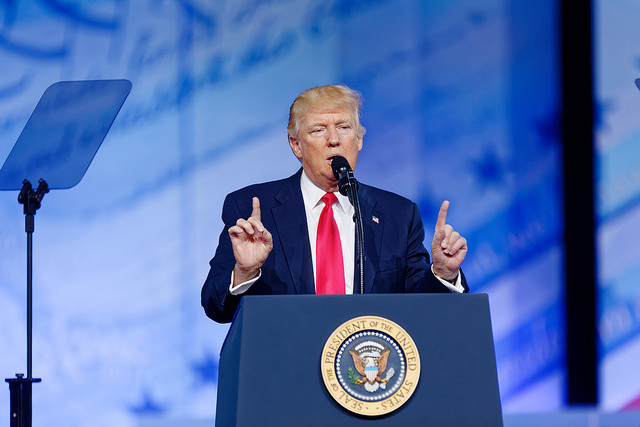
President Trump will soon meet Chinese President Xi Jinping. There will be much to discuss.
Since President Trump assumed office in January, the stock market is up and the unemployment rate is low. Still, something doesn’t feel quite right with the economy.
You won’t hear that from the president’s Twitter account, or the millions of people who voted for him. Polling shows that economic optimism has soared among Trump supporters since the election. But behind this sugar rush, I guarantee anxiety remains.
It’s not anxiety unfounded. The raise America got was a pittance — only 2.2 percent in the last year, which barely keeps up with inflation. And the jobs we’ve created in the last decade don’t typically pay as well as those we’ve lost.
There are approximately 5 million fewer American manufacturing jobs today than there were 17 years ago, and that can’t be explained away by increased productivity or automation. This slide was borne of a specific policy decision: normalizing trade relations and open our markets to China, which a bipartisan Washington did in 2000.
A recent report from the Economic Policy Institute parses 15 years of data with what is now our largest trading partner, and found dismaying results:
1. Between 2001 and 2011, trade deficits with China reduced the incomes of impacted American workers by an annual $37 billion.
2. From 2001 to 2015, 3.4 million jobs to the China trade deficit, the majority of them in manufacturing.
3. The losses weren’t always where you would expect: Although the president speaks a lot about real job losses in the steel and auto sectors, it was computer and electronic parts manufacturing jobs that were hardest hit.
4. The most affected states weren’t surprising, too: Oregon, Minnesota, and Massachusetts were among them.
President Trump’s language targets the economic unease caused by uneven trade. But how do you turn around a trading relationship with China that — in 2016 alone — had the U.S. buying $347 billion more than it sold?
You get serious about a new trade policy, and you get your own house in order.
A. It means going big on an infrastructure project, and making all of it American-made. Even voters who oppose the president think Washington should invest in repairing our roads, bridges, rails, and waterways.
B. It means strengthening our defense industrial base. We spend more money on our defense than any other nation on Earth. It makes no sense to allow China or Russia to buy strategic manufacturing assets in the U.S., or for the Pentagon to depend on foreign industries to arm and equip our military.
C. It also means that corporate tax reform must have “Made in America” front and center. Manufacturing faces global competition that retailers and banks don’t, and therefore should be able to quickly recover the costs of capital investments, and have the flexibility to weather the ups and downs of the business cycle.
Simultaneously, we must push China to comply with its trade obligations. President Trump is scheduled to meet his counterpart, Chinese leader Xi Jinping, next week. When he does:
D. It’s time the U.S. robustly asserted its rights and compelled China to fully comply with its trade obligations. That doesn’t mean erecting a 40 percent tariff wall, but it does mean targeted actions and reminding China of who really has market leverage.
E. It’s time the U.S. initiated actions to compel China to eliminate its industrial overcapacity, slim down its state-owned enterprises, and boost the value of the yuan.
F. It’s also time to stop offering China “carrots” until it takes meaningful actions. If China fully opens its economy to foreign direct investment from the United States, we can do the same for it. If China demonstrates that it is an actual market economy, we can treat it as such for trade purposes.
And this won’t start a trade war, as China needs our consumer market far more than we need China’s.
Say what you will about the president’s bellicose rhetoric, but he’s not entirely wrong: When it comes to trade — specifically with China — the American worker has been disadvantaged. A huge mass of President Trump’s voters went to the ballot box with that in mind, and many who opposed him agree with him on this point. Preparing the ground so this can be fixed should be the primary work of his presidency.
